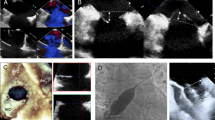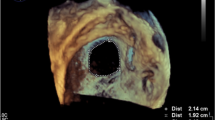Abstract
Percutaneous closure is the treatment of choice for secundum-type atrial septal defects (ASD). Balloon sizing (BS) has been the method of choice for deciding on device size. Improved 2D- and 3D-transesophageal echocardiographic (TEE) imaging challenged the necessity of BS. Balloon sizing was performed with two additional techniques to measure the stretched dimension of the ASD. The 1st method uses a stiff guide wire which stretches the ASD and 2D TEE. The second technique uses 3D TEE. Two hundred and thirty-six patients with minimum 1-year follow-up were enrolled. The population was classified into three groups: BS (group 1) n = 90, 2D-TEE (group 2) n = 87, and 3D-TEE (group 3) n = 59. All groups showed a distinct correlation between the maximum baseline dimensions and the device size (R = 0.821). The relative expansion rate did not differ between BS and 3D-TEE. Group 2 (2D-TEE) showed a significantly lower expansion rate. Procedural success and complications did not differ statistically between the 3 groups. 2D TEE sizing was the simplest method without loss of accuracy. 3D sizing offers the advantage of accurate and fast shape assessment, but resulted in more undersizing. Accurate sizing of ASDs with a floppy septum remains a challenge.


Similar content being viewed by others
References
Kazmouz S, Kenny D, Cao QL, Kavinsky CJ, Hijazi ZM (2013) Transcatheter closure of secundum atrial septal defects. J Invasive Cardiol 25:257–264
Butera G, Biondi-Zoccai G, Sangiorgi G, Abella R, Giamberti A, Bussadori C, Sheiban I, Saliba Z, Santoro T, Pelissero G, Carminati M, Frigiola A (2011) Percutaneous versus surgical closure of secundum atrial septal defects: a systematic review and meta-analysis of currently available clinical evidence. EuroIntervention 7:377–385
Chessa M, Carminati M, Butera G, Bini RM, Drago M, Rosti L, Giamberti A, Pome G, Bossone E, Frigiola A (2002) Early and late complications associated with transcatheter occlusion of secundum atrial septal defect. J Am Coll Cardiol 39:1061–1065
Hascoet S, Warin-Fresse K, Baruteau AE, Hadeed K, Karsenty C, Petit J, Guerin P, Fraisse A, Acar P (2016) Cardiac imaging of congenital heart diseases during interventional procedures continues to evolve: pros and cons of the main techniques. Arch Cardiovasc Dis 109:128–142
Ostermayer SH, Srivastava S, Doucette JT, Ko HH, Geiger M, Parness IA, Love BA (2015) Malattached septum primum and deficient septal rim predict unsuccessful transcatheter closure of atrial communications. Catheter Cardiovasc Interv 86:1195–1203
Mallula K (2012) Recent changes in instructions for use for the Amplatzer atrial septal defect occluder: how to incorporate these changes while using transesophageal echocardiography or intracardiac echocardiography? Pediatr Cardiol 33:995–1000
McElhinney DB, Quartermain MD, Kenny D, Alboliras E, Amin Z (2016) Relative risk factors for cardiac erosion following transcatheter closure of atrial septal defects: a case-control study. Circulation 133:1738–1746
Carlson KM, Justino H, O’Brien RE, Dimas VV, Leonard GT Jr, Pignatelli RH, Mullins CE, Smith EO, Grifka RG (2005) Transcatheter atrial septal defect closure: modified balloon sizing technique to avoid overstretching the defect and oversizing the Amplatzer septal occluder. Catheter Cardiovasc Interv 66:390–396
King TD, Thompson SL, Mills NL (1978) Measurement of atrial septal defect during cardiac catheterization. Experimental and clinical results. Am J Cardiol 41:537–542
Gupta SK, Bijulal S, Tharakan JM, Harikrishnan S, Aji KV (2011) Trans-catheter closure of atrial septal defect: balloon sizing or no Balloon sizing—single centre experience. Ann Pediatr Cardiol 4:28–33
Hascoet S, Hadeed K, Marchal P, Dulac Y, Alacoque X, Heitz F, Acar P (2015) The relation between atrial septal defect shape, diameter, and area using three-dimensional transoesophageal echocardiography and balloon sizing during percutaneous closure in children. Eur Heart J-Card Img 16:747–755
Harikrishnan S, Narayanan NK, Sivasubramonian S (2005) Sizing balloon-induced tear of the atrial septum. J Invasive Cardiol 17:546–547
Bhaya M, Mutluer FO, Mahan E, Mahan L, Hsiung MC, Yin WH, Wei J, Tsai SK, Zhao GY, Yin WH, Pradhan M, Beniwal R, Joshi D, Nabavizadeh F, Singh A, Nanda NC (2013) Live/Real time three-dimensional transesophageal echocardiography in percutaneous closure of atrial septal defects. Echocardiography 30:345–353
Vijarnsorn C, Durongpisitkul K, Chanthong P, Chungsomprasong P, Soongswang J, Loahaprasitiporn D, Nana A (2012) Transcatheter closure of atrial septal defects in children, middle-aged adults, and older adults: failure rates, early complications; and balloon sizing effects. Cardiol Res Pract 2012:584236
Sobrino A, Basmadjian AJ, Ducharme A, Ibrahim R, Mercier LA, Pelletier GB, Marcotte F, Garceau P, Burelle D, O’Meara E, Dore A (2012) Multiplanar transesophageal echocardiography for the evaluation and percutaneous management of ostium secundum atrial septal defects in the adult. Arch Cardiol Mex 82:37–47
Abdel-Massih T, Dulac Y, Taktak A, Aggoun Y, Massabuau P, Elbaz M, Carrie D, Acar P (2005) Assessment of atrial septal defect size with 3D-transesophageal echocardiography: comparison with balloon method. Echocardiography 22:121–127
Lodato JA, Cao QL, Weinert L, Sugeng L, Lopez J, Lang RM, Hijazi ZM (2009) Feasibility of real-time three-dimensional transoesophageal echocardiography for guidance of percutaneous atrial septal defect closure. Eur J Echocardiogr 10:543–548
McGhie JS, van den Bosch AE, Haarman MG, Ren B, Roos-Hesselink JW, Witsenburg M, Geleijnse ML (2014) Characterization of atrial septal defect by simultaneous multiplane two-dimensional echocardiography. Eur Heart J Cardiovasc Imaging 15:1145–1151
Simpson J, Lopez L, Acar P, Friedberg MK, Khoo NS, Ko HH, Marek J, Marx G, McGhie JS, Meijboom F, Roberson D, Van den Bosch A, Miller O, Shirali G (2017) Three-dimensional echocardiography in congenital heart disease: an expert consensus document from the european association of cardiovascular imaging and the American Society of Echocardiography. J Am Soc Echocardiogr 30:1–27
Haas NA, Soetemann DB, Ates I, Baspinar O, Ditkivskyy I, Duke C, Godart F, Lorber A, Oliveira E, Onorato E, Pac F, Promphan W, Riede FT, Roymanee S, Sabiniewicz R, Shebani SO, Sievert H, Tin D, Happel CM (2016) Closure of secundum atrial septal defects by using the occlutech occluder devices in more than 1300 patients: the IRFACODE project: a retrospective case series. Catheter Cardiovasc Interv 88:571–581
Johri AM, Witzke C, Solis J, Palacios IF, Inglessis I, Picard MH, Passeri JJ (2011) Real-time three-dimensional transesophageal echocardiography in patients with secundum atrial septal defects: outcomes following transcatheter closure. J Am Soc Echocardiogr 24:431–437
Weber C, Weber M, Ekinci O, Neumann T, Deetjen A, Rolf A, Adam G, Hamm CW, Dill T (2008) Atrial septal defects type II: noninvasive evaluation of patients before implantation of an Amplatzer Septal Occluder and on follow-up by magnetic resonance imaging compared with TEE and invasive measurement. Eur Radiol 18:2406–2413
Zhu W, Cao QL, Rhodes J, Hijazi ZM (2000) Measurement of atrial septal defect size: a comparative study between three-dimensional transesophageal echocardiography and the standard balloon sizing methods. Pediatr Cardiol 21:465–469
Roymanee S, Promphan W, Tonklang N, Wongwaitaweewong K (2015) Comparison of the occlutech (A (R)) figulla (A (R)) septal occluder and amplatzer (A (R)) septal occluder for atrial septal defect device closure. Pediatr Cardiol 36:935–941
Godart F, Houeijeh A, Recher M, Francart C, Polge AS, Richardson M, Cajot MA, Duhamel A (2015) Transcatheter closure of atrial septal defect with the figulla (R) ASD occluder: a comparative study with the amplatzer (R) septal occluder. Arch Cardiovasc Dis 108:57–63
Song J, Lee SY, Baek JS, Shim WS, Choi EY (2013) Outcome of transcatheter closure of oval shaped atrial septal defect with amplatzer septal occluder. Yonsei Med J 54:1104–1109
Seo JS, Song JM, Kim YH, Park DW, Lee SW, Kim WJ, Kim DH, Kang DH, Song JK (2012) Effect of atrial septal defect shape evaluated using three-dimensional transesophageal echocardiography on size measurements for percutaneous closure. J Am Soc Echocardiogr 25:1031–1040
Acknowledgements
We thank Ilse Coomans for guiding and correcting the statistics.
Funding
This research did not receive any specific grant from funding agencies in the public, commercial, or not-for-profit sectors. This Research was supported by the Belgian National Foundation for Research in Pediatric Cardiology.
Author information
Authors and Affiliations
Corresponding author
Ethics declarations
Conflict of interest
The authors declare that they have no conflict of interest.
Rights and permissions
About this article
Cite this article
Boon, I., Vertongen, K., Paelinck, B.P. et al. How to Size ASDs for Percutaneous Closure. Pediatr Cardiol 39, 168–175 (2018). https://doi.org/10.1007/s00246-017-1743-1
Received:
Accepted:
Published:
Issue Date:
DOI: https://doi.org/10.1007/s00246-017-1743-1




